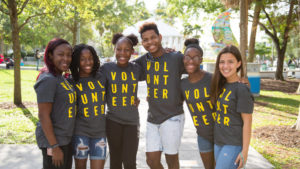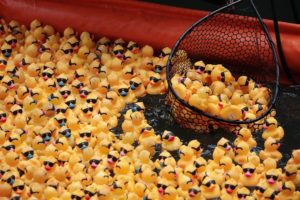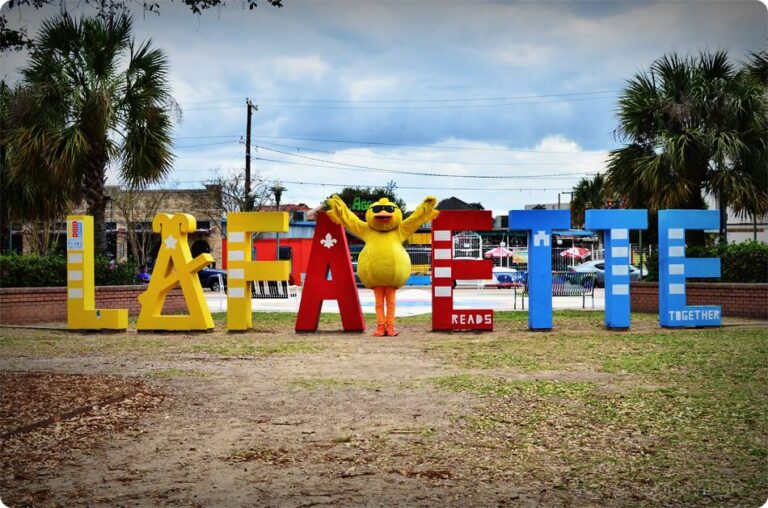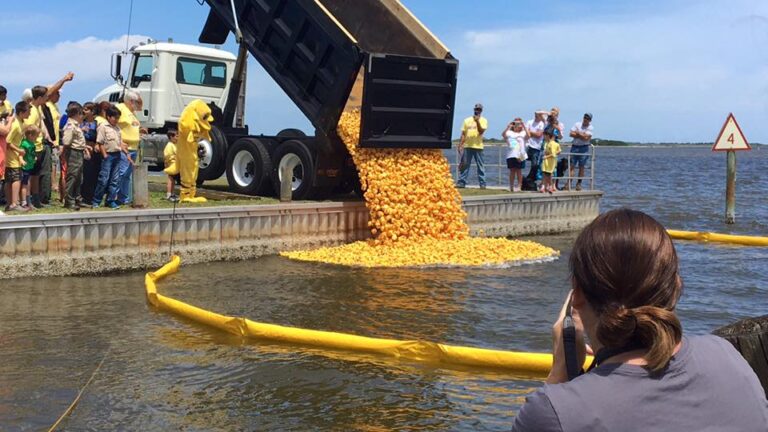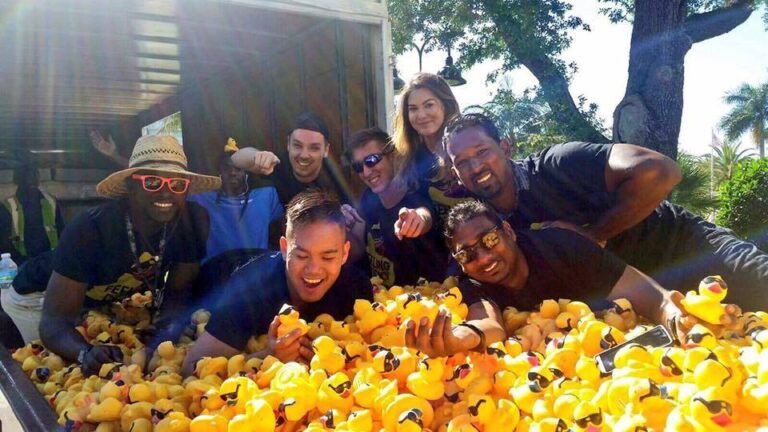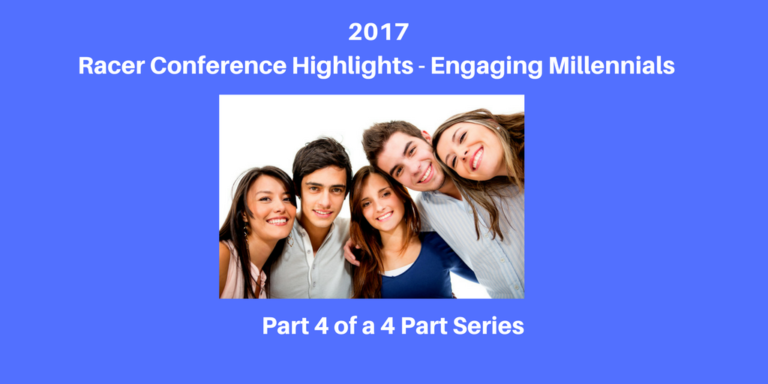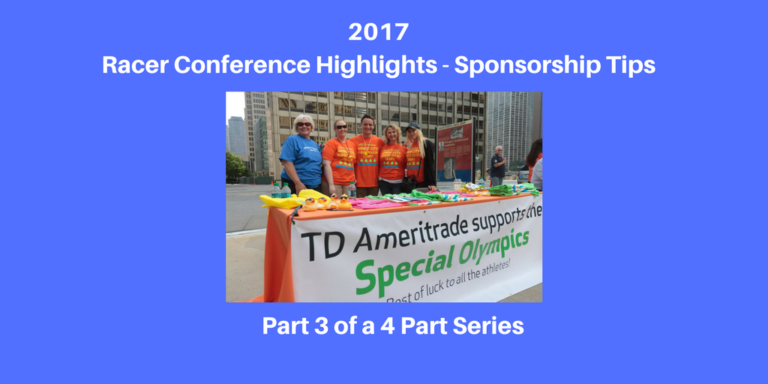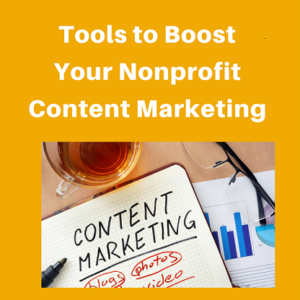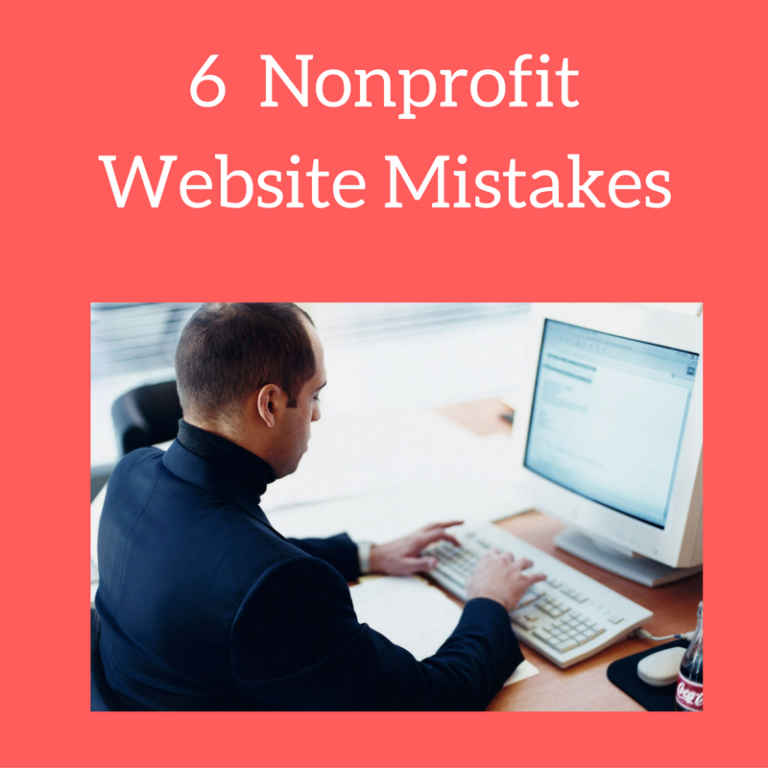27th Annual Great Acadiana Running of the Ducks
The 27th Annual Great Acadiana Running of the Ducks returns to Red Lerille’s Health & Raquet Club on Wednesday, April 5, 2017 for a ducky evening at the pool! From 5:30 p.m. – 7:30 p.m. EST duck race fans can enjoy music, family-friendly activities, and visit with Quacky the Duck. Fans can watch 30,000 rubber ducks slide down the waterslide into the pool where they will race to win one of 15 prizes! This year’s prizes include weekly combo meals for a year to Sonic and Burgersmith, jewelry from Armentor Jewelers and a $500 Visa Gift Card from Classic Auto Spa. In addition, other prizes include year membership at Red Lerille’s and a $500 gift certficate at La-Z-Boy Furniture! The quickest duck will win the grand prize of a 2017 Subaru Legacy from Giles Automotive.
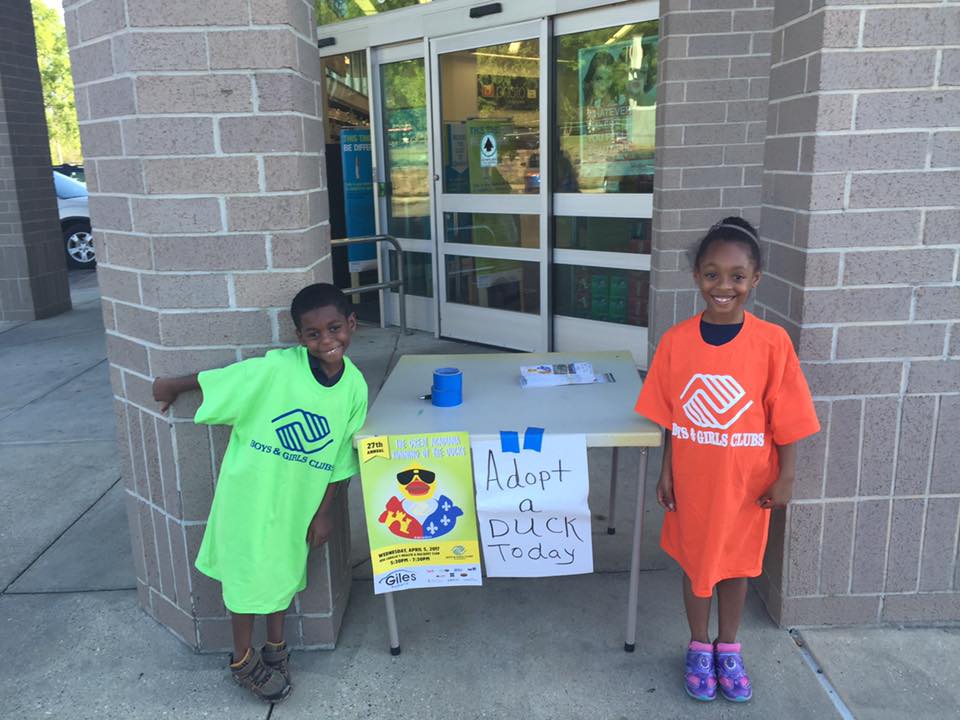
The best part of this evening is that all of the funds raised directly benefit the Boys & Girls Clubs of Acadiana! The Boys & Girls Clubs provides:
- A safe place for children to learn and grow…
- Ongoing relationships with caring, adult professionals…
- Life-enhancing programs and character development experiences…
- Hope and opportunity!
Adopt a Duck and Help a Child’s Future! Don’t miss out on this quacktacular event!
Racer Website: http://www.bgcacadiana.com/runnings-of-the-ducks/
- April 5, 2017
19th Annual Great Brevard Duck Race
The 19th Annual Great Brevard Duck Race is coming up this weekend on Sunday April 2, 2017. Adopt a duck for just 5 bucks and change lives!
Who: Crosswinds Youth Services
Crosswinds Youth Services has been serving young people and their families in Brevard County for over 40 years. Their mission is to create opportunities for young people to succeed. It began in the 1970’s with group of concerned community leaders who met to discuss how Brevard County, Florida could respond to the increasing number of runaway and homeless youth in the community.
Furthermore, Crosswinds Youth Services has been recognized nationally, regionally, statewide and locally. In 2013, it was chosen as Nonprofit Organization of the Year by the Titusville Area Chamber of Commerce. In addition, in 2014, it received a Central Florida Humanitarian Award.
Where: Titusville, FL at Sand Point Park
When: Sunday, April 2, 2017 at 1 p.m. EDT
Highlights: Adopt a Duck before they sell out! 10,000 rubber ducks are taking a dip in the Indian River as fans within the community can enjoy an afternoon of fun in the sun filled with family friendly activities, music, and food!
Prizes: In recognition of the 19th Annual Great Brevard Duck Race, a lucky duck adopter could be the winner of $10,000! Ten quacky prizes are going to be awarded to the top ducks including evening shark fishing, passes to Universal Studios & Islands of Adventure, flowers for a year, and more! In addition, other prizes include: a one-year family membership at any YMCA in Brevard and a two night stay at the Hilton Cocoa Beach Oceanfront. The fastest duck (owner) will set sail on a four-night cruise for 2 to the Bahamas about the Disney Dream!
Racer Website: www.greatbrevardduckrace.com
- March 29, 2017
We have races scheduled in Ft. Lauderdale and Texas City this weekend. Adopt a duck today and support some great nonprofits!
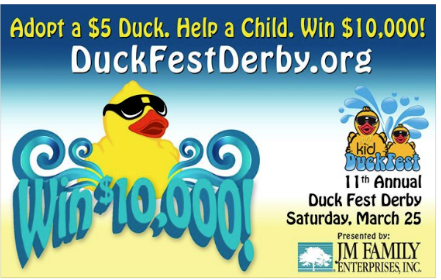 11th Annual KID Duck Fest Derby
11th Annual KID Duck Fest Derby
Who: Kids in Distress
Kids In Distress of Broward and Palm Beach counties (KID) works for the prevention of child abuse, preservation of the family, and the treatment of abused and neglected children.
Where: Ft. Lauderdale, FL at Esplanade Park
When: Saturday, March 25, 2017 starting at noon EDT.
Highlights: The KID Duckfest Derby is celebrating 11 years of racing rubber ducks and raising funds for their nonprofit organization. This year will feature multiple family friendly activities for the afternoon including a bounce house, petting zoo, face painting, funny photo opportunities, Meet and Greet with Splash, food trucks, and more! The KID Olympics returns for another year and each child who participates in every Olympic event will receive a chance to win a great raffle prize.
Prizes: At 2:00 p.m. 30,000 ducks will get their feathers wet as they race to win one of 10 prizes including a cruise for 2, a gift certificate from Carroll’s Jewelers, golf for 4, gift baskets, and more! The quickest rubber duck will win the $10,000 grand prize!
Racer Website: www.duckfestderby.org
10th Annual Texas City ISD Youthfest & Duck Derby

Who: Texas City ISD
The Texas City ISD (TCISD) Foundation for the Future, in collaboration with the community and the school district, support a quality education for the District’s students by generating and distributing resources to enrich, maintain, and expand programs to meet the District’s stated mission of excellence in education.
The Foundation encourages all students to work to their highest potential, supports staff teaching and learning programs. In addition, the Foundation inspires the community to participate with the school district to enrich education.
Where: Texas City, TX at Texas City Sting Creek
When: Saturday, March 25, 2017 from 11:00 a.m. – 4:00 p.m. CDT
Highlights: Get ready for an afternoon of fun at the Youthfest! There will be fun, food, music and entertainment and at 3:00 p.m. the ducks are launched.
Prizes: 5,000 Derby Ducks will paddle their hardest to win some great prizes including a $2,500 Visa gift card, a $1,000 Amazon gift card, a $250 HEB gift card, a 50″ TV, and more! All 10 prize winners will have the chance to win the “Lucky Duck” prize of a new $50,000 Ford car or truck sponsored by TNMP.
Racer Website: http://www.duckrace.com/texascity
- March 22, 2017
Our blog, 2017 Racer Conference Highlights – Engaging Millennials, is the final blog in a blog series highlighting tips from our Racer Conference in Scottsdale which we hosted in January of 2017. One of our speakers was Tiffany Hallier, Founder of Oh So Social who spoke on ways nonprofits can engage millennials who are individuals born between 1980 and 2000.
2017 Racer Conference Highlights – Engaging Millennials
- Millennials Enjoy Volunteering and Give Modestly to Multiple Social Causes. Their peers are a critical influence on millennial giving. Women give more money than men, and older individuals more than younger individuals. Making a difference in the world is more important than professional recognition.
- Main Social Media Channels. Their main social media channels are Facebook, You Tube, Instagram and Snapchat. Millennials do use Twitter but not as frequently. Millennials learn about and donate to causes digitally. The less steps they have to go through on their phone to donate, the better.
- Think of Instagram like a magazine. When you are posting content, use highly visual images that tell a compelling story and evoke emotion. Another idea for content is to include a call to action. Ask your followers to participate in your fundraising campaigns by going to the link in your bio and donate or buy a t-shirt, for example.
- Research Google Trends. Think by Google is a great resource includes data that Google is exploring and the trends they are tracking along with behind the scenes looks at digital campaigns – across industries, platforms and audiences.
- Read Millennial Impact Reports. The website Millenialimpact.com offers readers insights into how the Millennial generation connects with, gets involved with and supports causes.
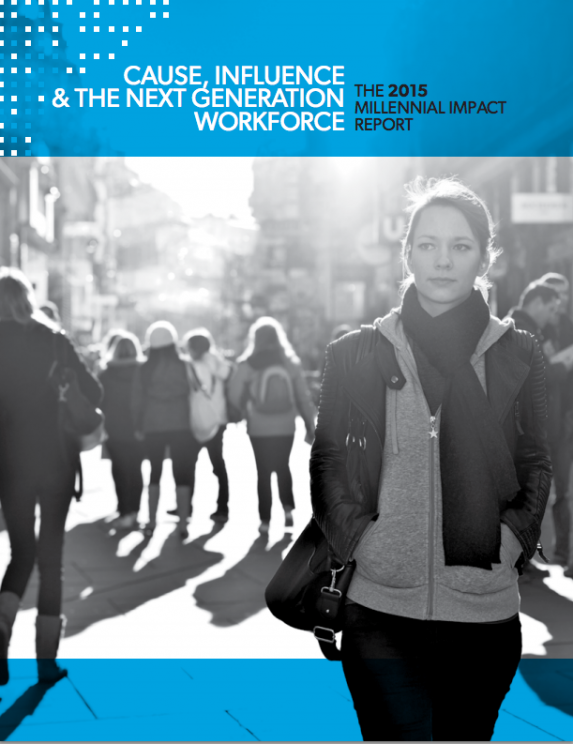
- Millennials Love Video. They value authenticity over the content itself and there are few things more authentic than live streaming.
- Create Advisory Boards. Ask millennials to serve on advisory boards where they can jump right in and get hands-on with causes they care about. Opportunities to use and develop their areas of expertise are prime motivators in millennials’ philanthropic engagement.
What Engages Millennials?
- Social Currency (sharing what makes us look good). An example could be sharing an image showing that “I care about pets or I support this children’s art therapy program.” Tag millennials and thank them when posting images on social media. Also, they love swag!
- Emotional Stories. Tell stories that create a meaningful connection. An example could be the story of a child who has overcome challenges and obstacles in the face of adversity. The Austin Boys and Girls Club posted a video of their 2015 Youth of the Year who had to go to McDonald’s to do her homework since there was no electricity or internet at her home. Another example of emotional storytelling is relating the power of a duck. For example, a single duck provides 1 meal to a Special Olympic Athlete during the State Games.
- Influencers. Millennials listen to influencers. Influencers are individuals who have the ability to influence the opinions and buying decisions of a target audience largely due to their social media following.
- Valuable Content. Post content that is easy to share such as quotes and infographics. Show real faces of the people in your organization.
- Mobile Friendly. Since the majority of millennials are accessing the web through their mobile phone, make sure that all of your content is mobile optimized.
- Hashtags – Make sure that you use hashtags so your content can be found. Hashtags are crucial on Instagram and Twitter. On Instagram, put your hashtags in a comment which will help your post look more authentic and less cluttered.
How does you nonprofit engage with millennials? We would enjoy hearing your comments!
- March 13, 2017
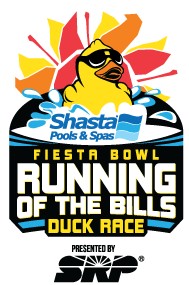
The rubber duck race returns to Arizona this weekend with the Fiesta Bowl Running of the Bills Duck Race. The Shasta Pools Fiesta Bowl Running of the Bills Duck Race will take place on Saturday, March 11, 2017. The event runs from 10:00 a.m. to 2:00 p.m. at the Scottsdale Waterfront. The day will be filled with food, music and lots of yellow rubber ducks! A total of 12,000 ducks will launch at noon and float down the Scottsdale Waterfront Canal while spectators cheer on their ducks. Proceeds from the duck race benefit Fiesta Bowl Wishes for Teachers. This organization grants wishes to K-12 teachers at public and charter schools in Arizona.
The VID Duck Adoption Package gives the duck adopter some special perks. You will receive a prime view of the duck race from a private patio overlooking the canal, catered food and drink tickets and interactive games.
The first 3 ducks through the finish line will win some amazing prizes! Prizes include: 50/50 of net duck proceeds, a weekend getaway and a Fiesta Bowl Fan Experience. The Fiesta Bowl Fan Experience includes: 4 PlayStation Fiesta Bowl Tickets, 4 Pregame On-Field Passes, 4 Stadium Club Pregame Party Tickets and 1 Parking Pass. Adopt a Duck, Grant a Wish!
Racer Website: www.duckrace.com/fiestabowl.com
- March 8, 2017
Have you found that keeping your social media and online channels current has become a daunting task? According to the Content Marketing Institute “54% of nonprofit professionals do not have a content strategy.” In addition, time and budget are top marketing challenges. Below are 5 content development strategies for nonprofits that will help you create content that is personal and engaging.
Content Development Strategies for Nonprofits
- Create a content calendar. First of all, plan your content week by week rather than scrambling to put something together for each of your marketing channels. Note special events, campaigns and holidays that you can develop content around. Trello is a free visual tool that allows you to organize projects into boards. You can also communicate with different team members on your projects.
- Use themes. What is your organization about? Pick one or two topics a month that you focus on and find content that relates to those topics. For example, an emergency services shelter could focus on mental health challenges facing children and families including depression, anxiety, and sensory disorders.
- Google alerts. Set up Google alerts to monitor and share what people are saying about your organization. In addition, Google alerts allow you to stay up-to-date on issues relating to your organization’s work.
- Involve your supporters. Ask donors and volunteers to share personal stories that you can share on your website and other marketing channels.
- Involve your staff. Content development does not need to just the responsibility of your communications department. Because your organization has individuals who are experts in your industry, they are a great resource for content ideas. You’d be surprised to find that many staff members love the opportunity to have a voice and share their insight!
With a little organization and by leveraging the individuals who are most invested in your cause, you set yourself on the right track to use a content development strategy to enhance your online marketing and as a result drive greater engagement! Share with us what type of content development strategy you have developed.
- March 7, 2017
Our blog, 2017 Racer Conference Highlights – Sponsorship Tips, is the third part in a blog series highlighting tips from our Racer Conference in Scottsdale which we hosted in January of 2017. Our clients who spoke gave some valuable takeaways on sponsorship acquisition.
2017 Racer Conference Highlights – Sponsorship Tips
- For the First Meeting, Don’t Bring a Sponsorship Packet. The first meeting you should find out all about the sponsor and what their needs are. Put yourself in your sponsor’s shoes. Furthermore, ask yourself questions such as: why the sponsor should partner with your nonprofit and what type of target market the sponsor will be able to reach through your event. After you discover what the sponsor is looking for, you can tailor a sponsorship packet designed to fit their needs. For example, a sponsor may want to increase traffic into his auto dealership and one way to do that would be to have a duck balloon in front of his dealership for two weeks prior to your duck race.
- Do Your Research. Find out what types of charities the CEO of a particular corporation supports. In fact, LinkedIn can give you insights as to what causes a people are passionate about and what organizations they support.
- Expand Your Sponsor List. Take your sponsor list and break it down even further. For example, if you have an auto dealership that is interested in sponsoring your event, look at contacting vendors who work with that auto dealership such as finance companies, body shops, detailing shops and auto parts stores.
- Sponsor Photo Book. Create a photo book that you can show your potential sponsors. Besides including photos of your nonprofit and duck race, include “What a Duck Can Do” images, past sponsor photos, and statistics about your nonprofit and duck race. Creating a book online will make it easier for you to update each year.

Other Sponsorship Tips
- Corporate Quack Attacks. Have your duck mascot surprise your sponsors with a Quack Attack. Take a picture of your duck mascot and make sure to include the sponsor’s logo somewhere in the picture.
- Sponsor Shout-outs on Social Media. Include sponsor shout-outs in your sponsorship proposal. Think about creating a unique idea for the sponsor such as dedicating a specific day to the sponsor. For example: “Trivia Tuesday is brought to you by Coffee House. Answer the following question correctly and be entered to win a $10 gift card to Coffee House.” Follow all of your sponsors on social media and interact with them which helps build a stronger relationship between your nonprofit and their business.
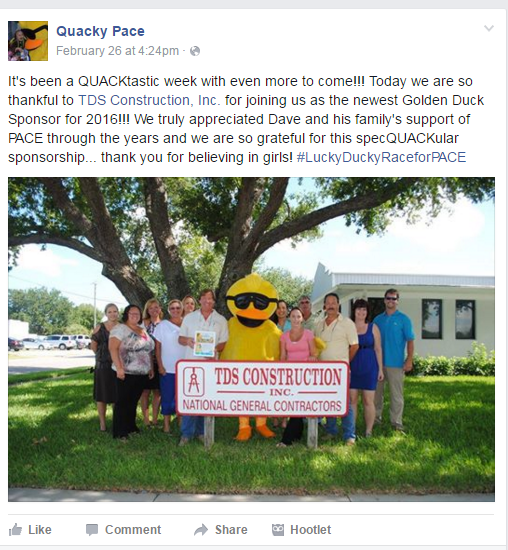
- Metrics. You should evaluate the amount of exposure a sponsor receives from your duck race event. Put together a comprehensive list of any exposure they received. Include any mentions of sponsors in social media posts, direct mail, press releases, email blasts, and any marketing materials.
Our last blog in our racer conference series will feature tips on how nonprofits can reach out to millenials.
- March 1, 2017
Nonprofits are continuing to use content marketing as a strategic marketing approach to distribute valuable content, attract audiences, and to ultimately drive action.
Here are some free tools to boost your nonprofit content marketing:
You can easily develop customer personas and when you are done inputting your data, you are given a customer snapshot that you can reference for your marketing campaigns.
The Yoast SEO WordPress Plug In is a great tool since it helps you keep your blog posts at a consistent length. In addition, you are able to add keywords to your blog posts.
This tool ensures that readability across your website remains consistent. It will suggest how to make your content more readable and will breakdown how much of your content is hard or very hard to read.
A popular organizational platform that allows you to capture, nurture and share your ideas across any device.
You can create to-do cards that are easy to edit and prioritize which helps you manage projects, stay on task and collaborate on content in real time.
Even if you aren’t planning on running a Google Adwords campaign, there are free tools to determine what keywords you should be using on your website to help with search engine optimization (SEO).
Allows anyone in your nonprofit to become a designer. You can create images for your website, blog, Facebook twitter, flyers, posters, invitations and so much more.
Create and publish interactive and engaging visual content such as charts and infographics.
This tool will score your headline quality and rates its ability to drive social shares, traffic and SEO value.
MailChimp has a free email platform for up to 2,000 subscribers and 12,000 monthly emails.
Allows you to analyze data across ads, videos, social tools, websites, tablets and smartphones to get a more complete view of your website visitors.
Share with us any tools that you use to help you with your content marketing strategy.
- February 22, 2017
Our blog, 2017 Racer Conference Highlights – Tips for Teams, is the second part in a blog series highlighting tips from our Racer Conference in Scottsdale which we hosted in January of 2017. Our nonprofit clients gave some valuable insights about ways to increase duck adoptions through teams.
Racer Conference Highlights – Tips for Teams
- Create Team Sales Kits. At your kick-off party, hand out teams sales kits in a reusable bag. In the bag include a sales guide, adoption papers, duck merchandise and t-shirts.
- Lunch and Learns. Set up lunch and learn events at larger businesses in your community. Special Olympics Illinois has sold up to 400 ducks in one day during a lunch and learn. Show a video about your organization and then have your Duck Ambassador speak about why you race ducks. Have your duck mascot go around the offices and encourage people to get a photo with him
- Lobby Events. Set up duck adoption events in the lobbies of large corporate buildings. Special Olympics Illinois gets businesses to form teams for these duck adoption events. The teams get competitive and compete for bragging rights.
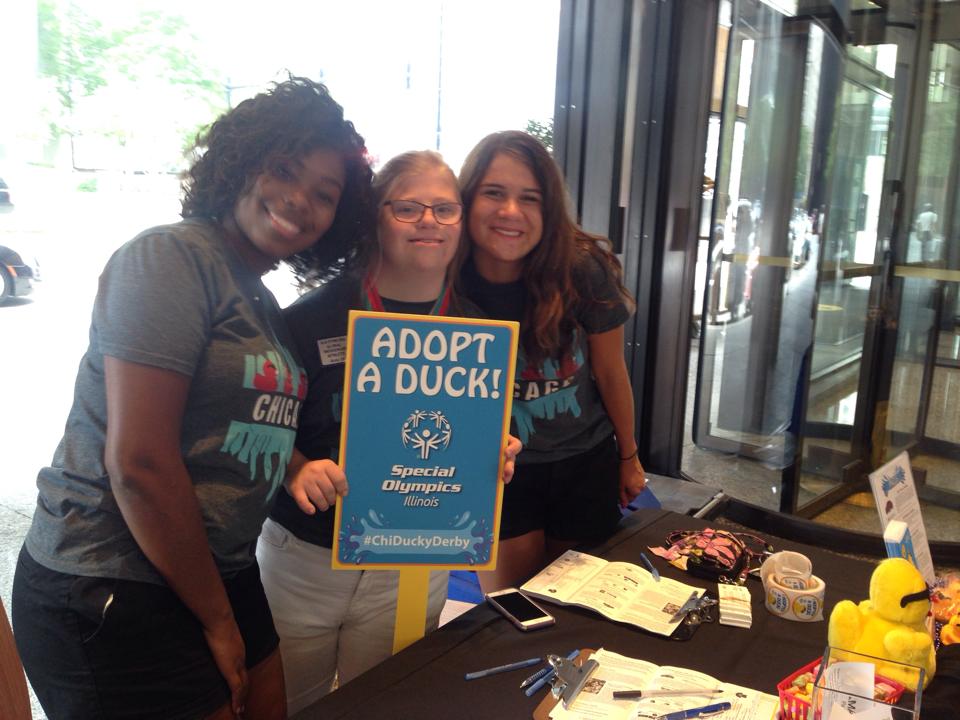
- Board Member Challenge. PACE Center for Girls in Manatee, Florida created a fun Celebrity Bartending event at a local restaurant who is a retail partner. Board members challenged each other for tips.
- Team Challenge. Challenge teams to win prizes by posting on social media that between a specific time period, the team with the most online adoptions will win their choice of a gift card.
Other Tips for Teams
- Duck Buddies. If you are a Kiwanis Club, you can ask local nonprofits if they would like to become a duck buddy and help sell duck adoptions. In return, these duck buddies will receive a certain percentage from each duck adopted.
- Duck Street Teams. The Austin Boys and Girls Club Foundation encouraged people to sign up for Duck Street Teams. Street Team volunteers helped post event flyers at local businesses in the community. As a result of signing up for the Duck Street team, they received a t-shirt, duck swag, and a gift card.
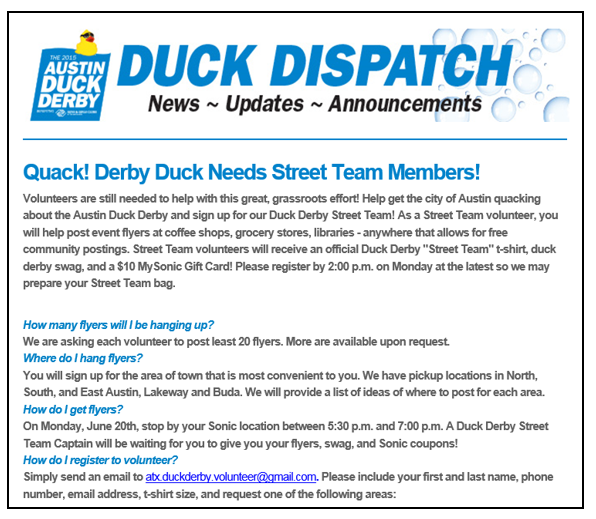
- Post Duck Team Party. Consider having a party after your duck race where you recognize the top sales people with gift cards.
- Retired people Make Great Salespeople. The Olympic Medical Center Foundation in Port Angeles, WA has discovered that people who have recently retired make great sales people and retirees have many friends they can sell duck adoptions to!
We will have future blogs featuring highlights from our racer conference in January of 2017. Keep checking back to our blog for future highlights.
- February 15, 2017
Your nonprofit website is one of the most important fundraising tools you have. A successful online strategy is one that attracts visitors to your website, engages them with content, and has a call to action.
Here are 6 nonprofit website mistakes and how to fix them:
- No contact information. Make it easy for website users to find your nonprofit’s phone number, email address or contact form.
- No Mission and vision. Who are you and what makes you stand out? Make your vision and mission visible so that donors can understand how their donation will make a difference.
- Donate call to action button is missing. Don’t bury your donation link or button at the bottom of your website. It should be on the top of the page so visitors do not have to scroll down to see it. Use a branded donation form instead of a generic form and make sure that the form integrates with your CRM software.
- Your latest news is not featured. Have a specific place to share your latest news, upcoming events or volunteer opportunities. You can also include this information in a blog. Show visually compelling images of people benefitting from your services and show the impact of your work.
- Your website is not mobile responsive. A responsive website automatically adjusts to fit onto smaller mobile screens. As more people access the web with their phones, it is imperative that your website is set up in mobile responsive design. The number of smartphone users worldwide will surpass 2 billion in 2016 and is projected to grow to 6.1 billion by 2020.
- No social media links or a newsletter sign up. Provide social media links to make it easy for supporters to share your content. Ensure that your newsletter sign-up process is a simple and seamless.
Your website has to offer real value to your visitors and that is how you will build traffic and get people to return your website. How have you recently upgraded your website to make it more user friendly? Let us know!
- February 8, 2017
- Recent Posts
Recent Posts
